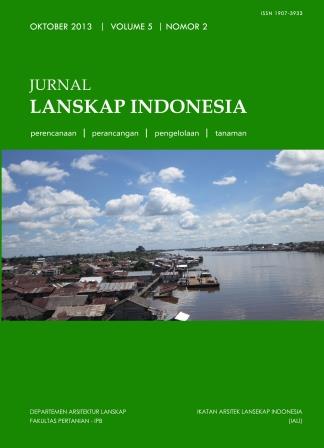EVALUASI KUALITAS VISUAL DAN FUNGSIONAL RUMPUT LAPANGAN SEPAKBOLA
Abstract
ABSTRACT Soccer is one of the popular sport around the world. Nowaday, Indonesia has more or less 170 soccer fields. Soccer requires fileds with excellent turfgrass which comply quality standards. This study was aimed to evaluate visual and functional qualities of soccer field, and propose recommendations related to management of soccer field that can fulfill visual and functional qualities. This study was conducted at three soccer stadiums namely Gelora Bung Karno Stadium (Jakarta), Si Jalak Harupat Stadium (Bandung), and Maguwoharjo Stadium (Yogyakarta). Survey and sampling methods were used together with interview method. Sampling based on parameter of visual and functional qualities. Then, analyzed by compare the data with standard quality. Planting medium and leaves samples has taken to laboratory analyzed. Grass quality of Maguwoharjo Stadium has the lowest quality than the others because the shortage of fertilizer condition in planting medium. Consequently, it affected grass growth and performance. Bades on the existing problems, some improvements of planting medium fertility were needed to get the optimal growth and performance in Maguwoharjo Stadium, such as adding the lime and compost or zeolit into planting media to increase the soil pH and CEC (Cation Exchange Capacity).
Keywords: Fertilizing, mowing, planting medium, soccer grass field, visual and functional qualities
Downloads
This journal permits and encourages authors to post items submitted to the journal on personal websites or institutional repositories both prior to and after publication, while providing bibliographic details that credit, if applicable, its publication in this journal. However, after the article is submitted and published in this journal, it is fully copyrighted by the Jurnal Lanskap Indonesia or JLI. If excerpts from other copyrighted works are included, the author must obtain written permission from the copyright owner and give credit to the source in the article. Then, the writer or reader is allowed to copy, share, and redistribute articles/material in any form. But it must still include the appropriate source and credit because the article in this journal is licensed by Creative Commons Attribution 4.0 International License (CC BY 4.0).
I. Proposed Policy for Journals That Offer Open Access
Authors who publish with this journal agree to the following terms:
- Authors retain copyright and grant the journal right of first publication with the work simultaneously licensed under a Creative Commons Attribution License that allows others to share the work with an acknowledgement of the work's authorship and initial publication in this journal.
- Authors are able to enter into separate, additional contractual arrangements for the non-exclusive distribution of the journal's published version of the work (e.g., post it to an institutional repository or publish it in a book), with an acknowledgement of its initial publication in this journal.
- Authors are permitted and encouraged to post their work online (e.g., in institutional repositories or on their website) prior to and during the submission process, as it can lead to productive exchanges, as well as earlier and greater citation of published work (See The Effect of Open Access).
II. Proposed Policy for Journals That Offer Delayed Open Access
Authors who publish with this journal agree to the following terms:
- Authors retain copyright and grant the journal right of first publication, with the work after publication simultaneously licensed under a Creative Commons Attribution License that allows others to share the work with an acknowledgement of the work's authorship and initial publication in this journal.
- Authors are able to enter into separate, additional contractual arrangements for the non-exclusive distribution of the journal's published version of the work (e.g., post it to an institutional repository or publish it in a book), with an acknowledgement of its initial publication in this journal.
- Authors are permitted and encouraged to post their work online (e.g., in institutional repositories or on their website) prior to and during the submission process, as it can lead to productive exchanges, as well as earlier and greater citation of published work (See The Effect of Open Access).



























